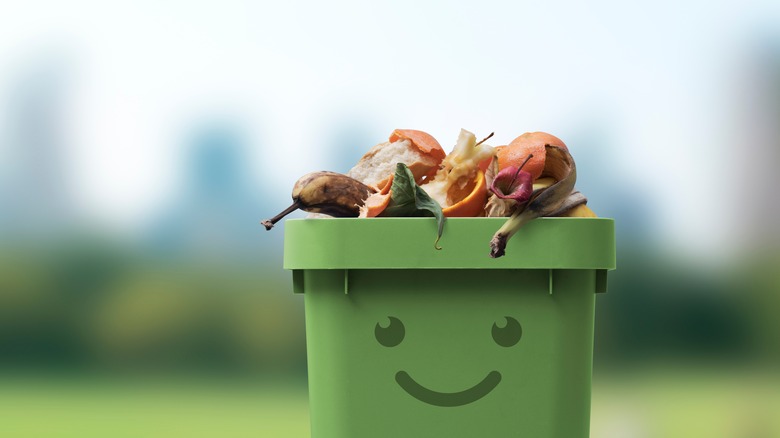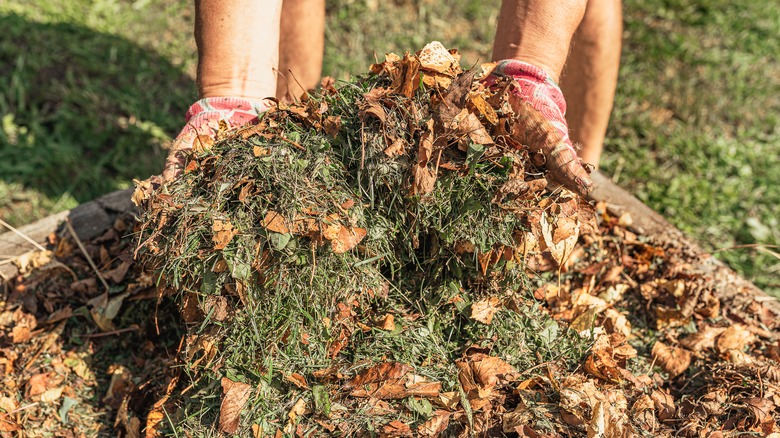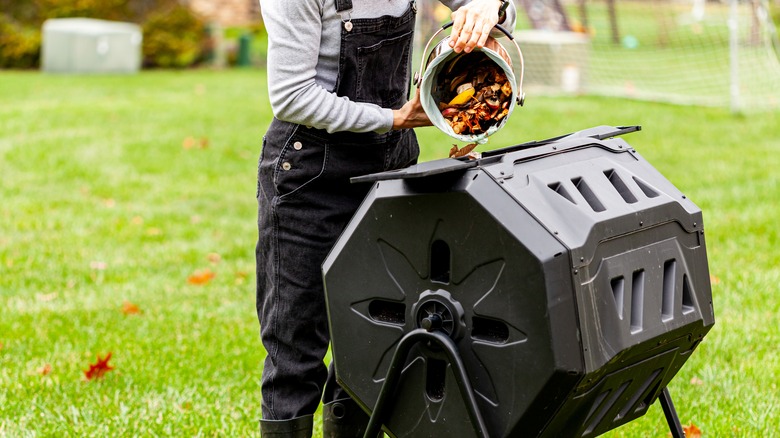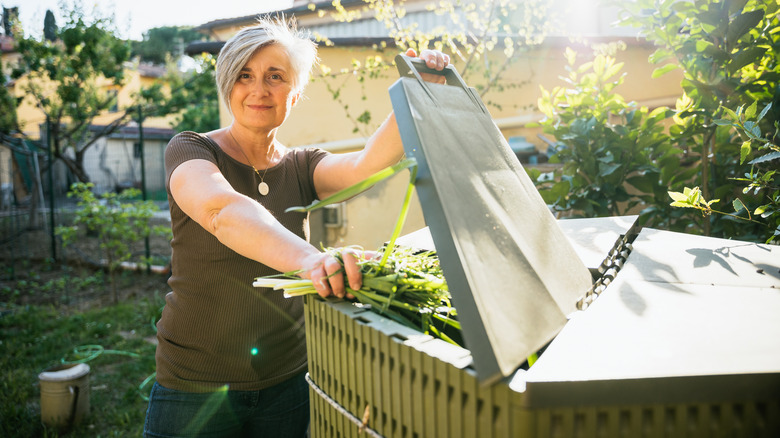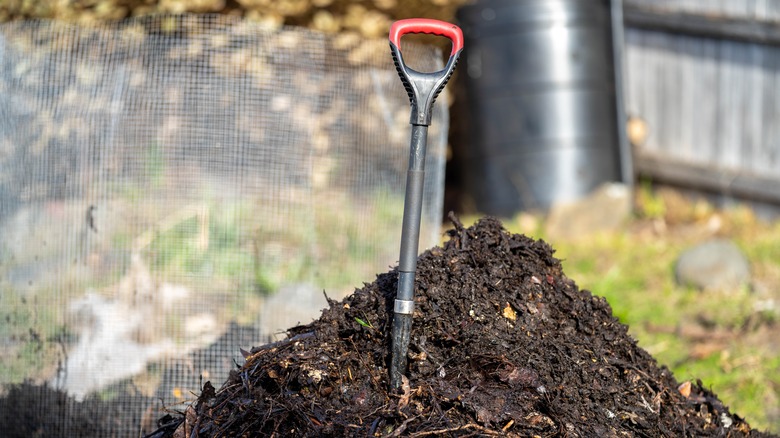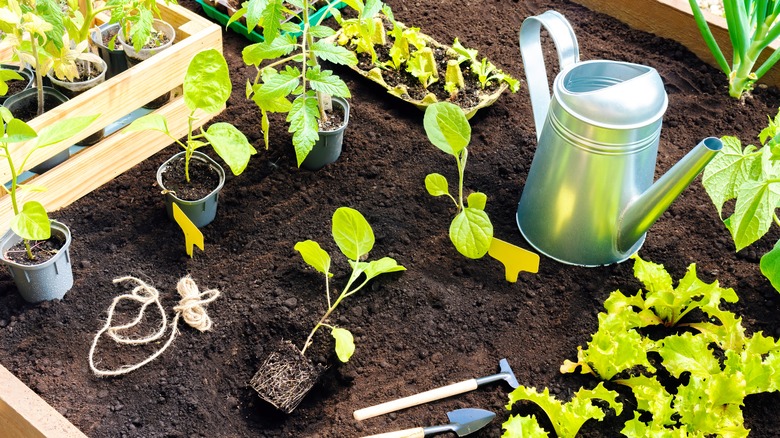5 Tips For Composting Throughout The Winter Months
Composting creates nutritious soil for your plants while lowering your carbon footprint. It allows you to use food scraps and yard waste that would otherwise end up in a landfill. The United States Environmental Protection Agency explains that this waste makes up over 30% of what gets thrown away but could get reused as compost. Reusing these things prevents them from releasing potent greenhouse gases, like methane, that break down the ozone and increase the rate of global warming (via the UN Environment Programme).
To compost at home, you need water, green material, and brown material. Green material is scraps from your kitchen, like fruits, vegetables, eggshells, coffee grounds, or tea bags. Brown material comes from your yard, like lawn trimmings, plants, or leaves, and from paper items like newspaper or cardboard. Once your compost is ready for harvesting, it'll give your plants the nutrients they need to grow, help them retain moisture, and prevent disease. While compost will become active rapidly during the summer, you must prepare to keep it going during the winter.
1. Collect and save brown matter
In the winter, plants go dormant and aren't focused on growing. They'll have already lost all their leaves in the fall, so there won't be any brown material for you to collect in the winter, especially if a thick layer of snow is covering the ground. You'll still need brown matter for your compost, though, so you must stockpile all the brown material you can find before the winter months.
Fall is a great time to start this stockpile because trees will be losing their leaves. You should collect dry leaves, pine needles, straw, woodchips, sawdust, newspaper, and cardboard. Cornell Cooperative Extension recommends storing your brown matter in covered garbage cans or plastic garbage bags because you don't want them to become exposed to moisture. If they were to get wet, they could start breaking down before you added them to the compost. You'll need a lot of brown matter in the winter, so gather as much as you can from your yard and consider using your neighbors as well.
2. Insulate your compost
You need so much brown matter during the winter because it'll also act as a layer of insulation. Compost is able to decompose faster in warmer weather, so if your material becomes exposed to freezing temperatures, the microbial activity needed to break things down will stop, according to Pela Earth. Luckily, there are multiple things you can do to insulate your compost.
Using a pre-insulated compost bin is the easiest thing you can do to prepare for cold weather. If you can't access this type of bin, you can create your own insulation. First, you should move your container to the sunniest part of your yard. Then use your brown matter to line the inside of your container with about 6 to 12 inches of material. After that, you can add even more insulation by covering your compost bin or pile with flattened cardboard boxes, old blankets, and a tarp.
3. Monitor the moisture
The amount of moisture in your compost is also important for keeping the microbes alive during winter. Depending on where you live, lots of rain or snow can affect your compost if it isn't protected. Carry On Composting explains that you want to maintain about 40% to 60% moisture. If you were to have too much, your material would smell, the nutrients wouldn't be able to stay in the compost, and it'll develop slower. Too little water will dry out the materials and cause the microbes to become dormant and die.
Using a compost tumbler or sealed bin will help you to control the amount of moisture added because they'll stop any rain or snow from getting inside. You can also add carbon materials to the tumbler to absorb excess water. If you use a compost pile, this can be tricky. Covering them with tarps will help keep the elements out and add insulation. However, you need to be careful because rain will get soaked into the ground and can reach the underside of your pile.
4. Turn it less frequently
Turning your compost is necessary to assist in decomposition and increase airflow. Happy Sprout explains that to turn your compost correctly, you should move the materials from the center to the outside. During the summer, you do this frequently since there's a lot of microbial activity; that's when you do it about every two weeks. However, you can't follow the same schedule during winter.
The weather is colder during the winter months, so you should stop turning your compost until the temperature increases around springtime. While your compost would like the decomposition boost that occurs when you mix it, increasing airflow will bring in the cool winter air. Doing this would risk releasing the warm air you worked hard to insulate and expose your materials to freezing temperatures that will kill them. Once it's approaching the end of fall, you should stop turning your compost.
5. Harvest finished compost
Harvesting your finished compost before it's wintertime is the simplest way to prepare your bin for the cold. You want to move your ready compost out of your container because you will need more room during the cold months than you do during the summer, according to the University of New Hampshire. Since decomposition occurs slower in winter, you need room to add more materials without taking any out. You also need space for 6 to 12 inches of insulation if your bin doesn't already have any built-in.
You can identify if your compost is ready to be harvested by the way it looks. It should be dark, crumbly, and not resemble any of the materials you added. It will also have a distinct earthy smell. Once you remove this finished compost, you can use it immediately or store it in covered bins. If you don't want to put it in containers, piles with a tarp over them will also work.
